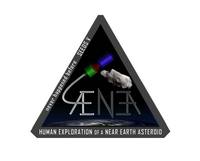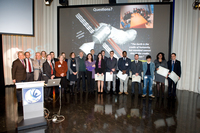Astronomen hebben met ruimtetelescoop Hubble een sterrenstelsel gevonden dat 480 miljoen jaar na de oerknal al bestond.
Daarmee is het stelsel het verst van ons verwijderde en het vroegst ontstane sterrenstelsel dat we tot nu toe hebben waargenomen. Bijzonder is echter vooral dat het om maar één stelsel gaat. Op basis van eerdere waarnemingen zou je er namelijk minstens een paar verwachten.
Waar het bij dit onderzoek om draait, is de vraag wanneer de eerste sterrenstelsels in ons inmiddels 13,7 miljard jaar oude heelal ontstonden. Om die te beantwoorden, is het van belang om voor allerlei verschillende tijdstippen na de oerknal het aantal stelsels te ‘turven’. Hoeveel sterrenstelsels waren er één miljard jaar na de oerknal? Hoeveel 750 miljoen jaar na de oerknal? Enzovoort.
Een beperking daarbij is dat hoe verder je het verleden in wilt gaan, hoe dieper je het heelal in moet kijken. Dat is een gevolg van het gegeven dat licht tijd nodig heeft om afstanden te overbruggen. Zo heeft zonlicht acht minuten nodig om de aarde te bereiken, met als gevolg dat we de zon zien zoals hij acht minuten geleden was. Kijken we naar de veel verder weg gelegen sterren aan de nachtelijke hemel, dan zien we die zoals ze jaren geleden waren. En willen we het heelal zien zoals het enkele honderden miljoenen jaren na de oerknal was, dan moeten we nóg veel verder kijken; zo ver als nodig is om ervoor te zorgen dat licht dat in de gewenste periode werd uitgezonden ons nu bereikt.
Sterrenkundige Rychard Bouwens van de Universiteit Leiden en collega’s hebben dat laatste gedaan, voor het tijdstip van 480 miljoen jaar na de oerknal. Daartoe lieten ze de Hubble Space Telescope met een in mei 2009 geïnstalleerde infraroodcamera 87 uur naar hetzelfde plekje aan de hemel turen. De reden daarvoor: het gaat hier om objecten op zulke grote afstanden, dat je een extreem lange belichtingstijd nodig hebt om er nog íéts van te kunnen zien. De oogst van deze onderneming, zoals gezegd: één enkel sterrenstelsel. (Tenminste, daar lijkt het op; er is een geschatte kans van 20 procent dat we met iets anders te maken hebben.)
Wat deze vondst interessant maakt, is dat eerdere waarnemingen van 630 miljoen jaar na de oerknal enkele tientallen sterrenstelsels aan het licht brachten, terwijl er voor de periode van 900 tot 1200 miljoen jaar na de oerknal zelfs enkele duizenden zijn gevonden. Oftewel: hoe langer na de oerknal, hoe meer sterrenstelsels. Logisch ook; toen het heelal ontstond, waren er geen sterrenstelsels, enkele miljarden jaren later waren er talloze; in de tussentijd moeten ze dus stukje bij beetje zijn ontstaan. Maar trek je die trend door naar het verleden, dan zou je bij 480 miljoen jaar na de oerknal op zijn minst een paar sterrenstelsels verwachten – niet ééntje-of-misschien-zelfs-geen.
De conclusie die we uit dit gebrek aan sterrenstelsels kunnen trekken: in de periode van 480 miljoen jaar na de oerknal tot enkele honderden miljoenen jaren later ontstonden sterrenstelsels rapper dan verwacht. En: het stelsel dat Bouwens en collega’s hebben gevonden, zou weleens een van de eerste exemplaren van ons heelal kunnen zijn.
Beeld: G. Illingworth/R. Bouwens/HUDF09 Team/ESA/NASA



